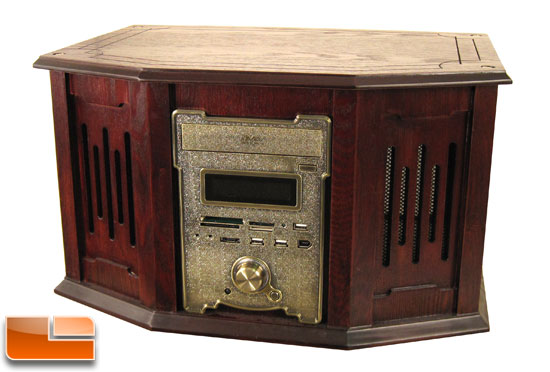nMediaPC HTPC 8000 Wooden HTPC Case
External Impressions

With the case out of the packing we can get a good look at it. One thing is for sure; you will need certain dcor for the HTPC800 to blend in. With the case resembling a 1940s radio I dont think it will fit in with most of todays sleek AV equipment. If that is more your style, nMediaPC has those too.

Looking a little closer at the front panel we can see it’s done in a style to resemble brass, but its actually plastic. There is a space for an LCD screen — more on that in a moment. Just below the screen are the card reader and front I/O ports. The I/O ports include three USB ports, eSATA, IEEE1394, and the Audio ports. Now the big knob is not a knob, but a big power button. First thing I did when I got the case out of the box was try to turn the knob, as did anyone else I know thats looked at the case. To the lower right of the power button is the reset button. To the lower left is the hard drive LED.

On either side of the front panel are the front vents. These have a mesh screen behind them and as Ill show later, they are not removable so cleaning dust off may be interesting.

The sides of the HTPC 8000 have plastic handles inset into them to help move the case around. With the case being made of wood it is not light. Fully packed with parts the HTPC 8000 is a bit on the hefty side.

The top of the case has a two small groove details in it. Other than that the top is blank. The top is also the access panel to the inside of the case. It is held on with four screws, one in each corner.

Around the back we can see the only fan in the case, a single 140mm fan. The directions also say you have the ability to add two 92mm fans that you can purchase on your own in the front behind the panel.

Looking closer to the expansion slot area we can see that the slot covers are stamped. The black piece with holes is a vent, but is also removable for installing expansion cards.

The bottom of the case is not as finished as the rest of the sides. The case feet are the rubber stick on type. The four holes in the center are left from the manufacturing process.

Comments are closed.